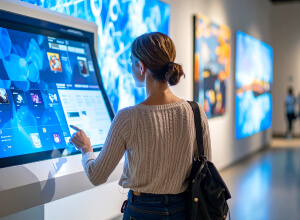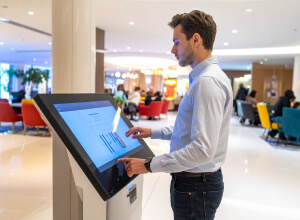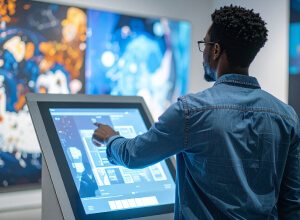Choosing a Digital Signage Platform

IntuiFace now supports six different platforms for interactive deployment. Here are our pros and cons for each.
With our recently announced support for Chrome OS - and the soft announcement of our pending LG webOS support (more information to come) - IntuiFace has a lineup of six platforms available for deployment. This unprecedented volume of platform support - the widest in the industry for no coding interactive content creation - gives us a unique vantage point.
To support each platform we've had to become intimately familiar with them. Each has quirks requiring special high-end development. Then, of course, everything from price points to performance can vary widely.
In this article I thought I'd highlight what we consider the most relevent pros and cons for each platform as a digital signage option. Please note that these considerations are only in the context of IntuiFace. If you want to write your own code - and why would you when you have IntuiFace? - different considerations and observations may apply.
All platforms have their strengths and weaknesses. Any one may be optimal for your needs.
Windows
Pros
- Performance. A well-spec'd PC will outperform any alternative platform supported by IntuiFace.
- Variety. Any size touchscreen is available - 12" Surface Pro to 110" PQ Labs overlay - plus you have the ability to create multi-display video walls.
- Capability. Widest range of features (e.g. you can run Flash in IntuiFace on Windows).
- Stability. Windows gets a bad rap historically but in our experience Windows 7, 8 and 10 are strangers to the blue screen of death and mystery freezes.
Cons
- Price. There are cost effective options - e.g. Intel NUC - but even then you'd still have to purchase a separate touch display, not to mention the cost of the OS itself. With performance and quality comes ever increasing price tags.
- Sharing. Sharing with non-IntuiFace users can be difficult because you have no control over PC quality. A colleague with a low end, non-touch Windows 7 PC probably shouldn't use IntuiFace.
iOS on the iPad
(IntuiFace only runs on the iPad, not the iPhone, due to performance constraints on the phone)
Pros
- Popularity. Everyone has one so if you use our Post to Store service, anyone can use IntuiFace.
- Reputation. Use an iPad as a kiosk and you're instantly chic.
- Performance. IntuiFace performs quite well when experiences are appropriately designed. (See Cons for "Content Scalability".)
Cons
- Content Scalability. iPads are still, at bottom, mobile devices and thus not intended to accommodate the display of multiple, large HD images, videos, 3D models, etc. In other words, just because you can do it with IntuiFace doesn't mean you can get away with it on the iPad. We give design recommendations here.
- Maintenance. iPads aren't expensive per se but maintenance costs can get high without much effort. Its easy to upgrade and repair a Windows PC; it is impossible to uprgrade iPad hardware and a mere cracked screen can cost you 30% of the overall device price.
Android (both tablets and custom devices)
Pros
- Popularity. Like the iPad, Android tablets are quite common so if you use our Post to Store service, anyone can use IntuiFace.
- Configurability. Unlike the iPad, Android devices can be built out of component parts. This makes it possible to be sensitive to cost, minimize maintenance costs and upgrade a device over time.
- Performance. IntuiFace performs quite well when experiences are appropriately designed. (See Cons for "Content Scalability".)
Cons
- Content Scalability. As with the iPad, Android devices are not (yet) constructed to accommodate the display of multiple, large HD images, videos, 3D models, etc.. In other words, just because you can do it with IntuiFace doesn't mean you can get away with it on an Android device. We give design recommendations.
- Variability. Because of its configurability (see the Pros for "Configurability" above), it can be hard to predict how well IntuiFace will run. Cutting corners to save on cost might penalize performance. We're trying to create a benchmark test but to date it is quite hard to predict how well IntuiFace will perform on a custom Android device. For Android tablets, you should be fine with anything running Android Version 4.3 or later.
Chrome OS
Pros
- Cost. There's certainly a lot of variability here - from Chomebox to Chromebook to Chromebase. However, for not a lot of money you can buy a high performance device with integrated touch display.
- Performance. IntuiFace performs quite well when experiences are appropriately designed. (See Cons for "Content Scalability".)
- Management. Chrome Device Management makes it easy to remotely monitor your in-the-field devices, lock them down in kiosk mode, etc.
- Offline support. Most Chrome-based signage options require that one is online at all times. IntuiFace can work offline.
Cons
- Content Scalability. A recurring theme, as you may have noticed, with devices optimized for easy install and low power use. As we've mentioned, just because you can do it with IntuiFace doesn't mean the device can handle it.
Samsung SMART Signage Platform (SSP)
Pros
- Cost. The SSP has a low total cost of ownership. As an all-in-one there is nothing extra to purchase and it is quite easy to install.
- Flexiblity. You can use either the embedded system-on-a-chip or an external Windows PC.
- Offline support. Most SSP-based signage options require that one is online at all times. IntuiFace can work offline.
Cons
- Touch performance. The system-on-a-chip was optimized for static signage so adding interactivity requires modest content use.We give Design recommendations.
- Variety. There are many SSP options but only a small subset support touch. Look for the D or E series. The most popular options are the 10.1" and 22" displays but larger sizes are available.
LG webOS (we expect to formally announce support in November-2015)
Pros
- Cost. webOS has a low total cost of ownership. As an all-in-one there is nothing extra to purchase and it is quite easy to install.
- Offline support. Most webOS-based signage options require that one is online at all times. IntuiFace can work offline.
Cons
- Touch performance. webOS was optimized for static signage so adding interactivity requires modest content use. Design recommendations for the SSP equally apply to webOS. Once we formally announce webOS support, we'll publish dedicated documentation for it.
- Variety. There are many webOS options but only a small subset support touch. We'll be supporting the Smart Monitor Signage SM5B series.





